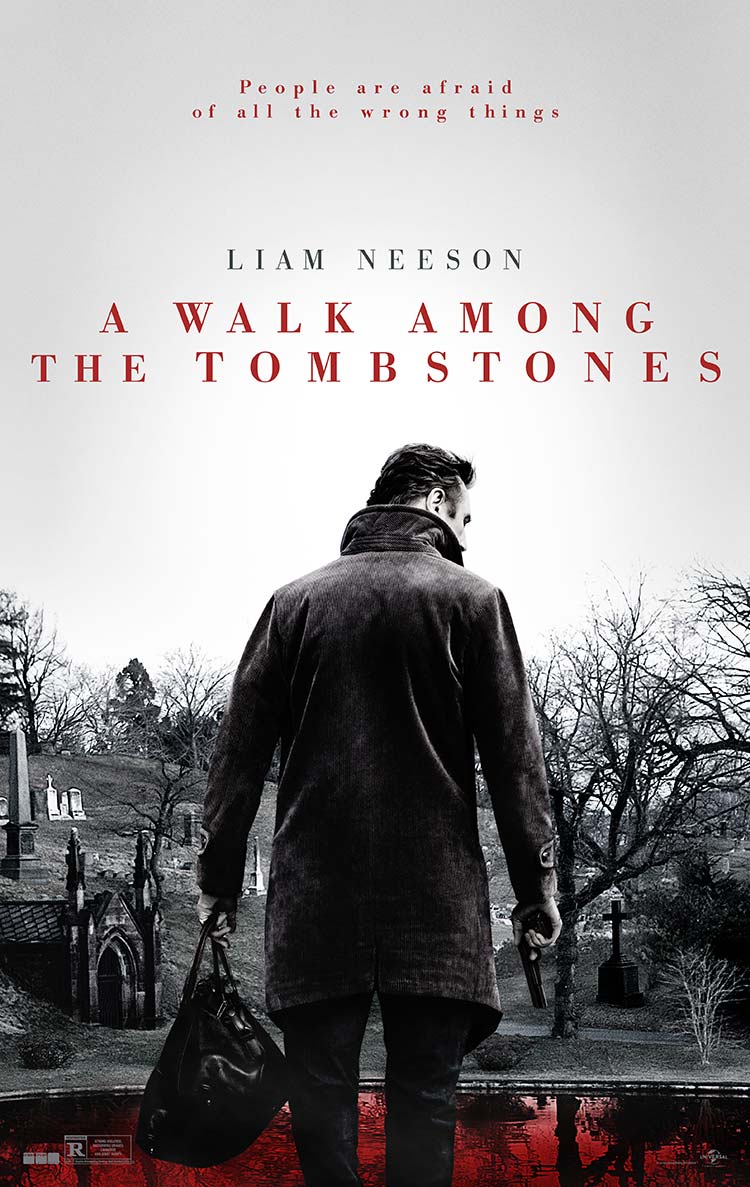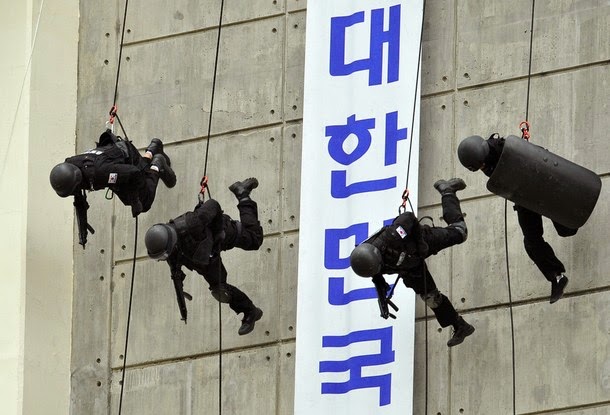David Dean's excellent blog post, which provided important details for those writing about Catholic characters, put me in mind of some other information you might find useful. And, naturally, given my background, these details tend to be military in nature. But, I see a lot of military techniques used in cop shows, and sometimes evidently by real police, these days. So I thought you might have seen some of these techniques, too, and that this info might interest you -- as mystery writers.
There are many places where a helicopter can't land, but people need to get off the helicopter and onto the ground below. Thick jungles or forests are such locations, but there are others you might not have considered. Think of the roofs of high-rise office buildings: they are often festooned with antennae that prevent a helicopter from landing. Yet, a helicopter -- if properly equipped -- can put people onto that roof, or take them off.
When helicopters can't touch down, but need to offload personnel, two options are fast-roping and rappelling. Fast-roping is faster than rappelling, but I've seen fictional law enforcement units using both methods on TV and in movies, so I'll cover both here.
 |
FAST ROPE OPERATION
Note the number of men sliding down each rope
at the same time. UH-60 Helicopter. |
 |
HELICOPTER RAPPEL OPERATION
Note that there is only man per rope
at any given time. UH-60 Helicopter. |
Viewed from a distance, Rappelling and Fast-Roping from helicopters can look very similar.
In both cases, people slide down ropes that hang out of helicopters.
But the person rappelling is usually
attached to the rope by a D-ring or snap-link, while a fast-roper is only attached by hands and feet.
 |
A coiled Fast-Rope: The eye-splice at
photo bottom is used to tie-into the aircraft. |
The ropes used by these two operations are quite different -- because they serve very different needs.
("Fast-Rope" can evidently be spelled with or without a hyphen, and even sometimes as a single word.) A fast-rope, itself, is a thick hawser-type rope about 1.5 to 2 inches thick. The ropes are pretty long -- 35 feet and 40 feet, I seem to recall. With a few that were about 60 or 70 feet. The number "78 feet" sticks in my mind as the greatest distance one can safely fast-rope -- though I may be wrong.
The rope needs to be thick, because the fast-roper needs something to hang onto. As I mentioned above, the fast-roper isn't tied or snapped to the rope. Instead, s/he gets down from the helicopter to the ground by grabbing the rope in gloved hands, and between boots, then sliding down the rope as if it's a firehouse pole.
 |
Fast-roping uses a thick rope that the roper slides down,
similar to sliding down a firehouse pole. |
Fast-roping is a quick way to empty a helicopter that can't land, because several people can slide down each rope at the same time. Hence the name "Fast-Rope": a rope used to empty a chopper fast.
 |
These fast-ropers are much better spaced (closer)
than the folks in the upper left pic. Going out closer
means you get more folks on the ground faster. |
On my old A-Team, we usually rode UH-60 or MH-60 Blackhawks (seen above) when we fast-roped, and would use two ropes to exit the aircraft: one per door. As we neared the objective, helicopter crewmen would prepare to deploy the fast-ropes, while we gathered in two groups, one around each rope, where it hooked to the chopper.
Everybody would grab the rope, in a specified well-rehearsed order -- the top of each man's hands touching the bottom of the hands of the man holding the rope above him -- ensuring no one's hands overlapped anyone else's.
When we hit the objective, the crewman dropped the rope coil out the door and leaned out to be sure the far end was dragging on the ground as the chopper moved slowly forward.
Simultaneously, our "doorman" would do the same thing with a quick glance (to ensure he didn't slide down the rope, only to plunge off the end.) Then he would swing out and jump his feet onto the rope, sliding down.
As the doorman went out, the man beside him rotated around and dropped down the rope, followed by the next guy, and the next. In this manner all twelve of us could descend the two fast-ropes, with our equipment, and be "weapons-up" in a matter of seconds. Due to the chopper's forward movement, we'd hit the ground about 2 or 3 meters apart.
The ticket with a fast-rope is that the friction generated between your gloved hands, and your boots, on the rope, slows you down enough that you don't get killed or injured by the drop. And that's A LOT of friction! I saw a buddy of mine, who tried to fast-rope without gloves one time. His palms and fingers looked like hamburger: horrifically blistered, torn and bleeding. He had to wear serious bandages for about two weeks. (To his credit, he fast-roped, wearing the bandages under his gloves, during those two weeks -- because it was VERY important. But it hurt him like heck, every time!)
On the web, I've seen photos posted by knuckleheads who prided themselves on letting go of the rope as they descended, only to grab it again later, to slow their descent. However, I strongly urge you not to let any fictional law enforcement personnel practice this foolish "showboating" in a story.
The fact is: the folks in those online pics are just Good-Time Charlies; they aren't carrying any equipment. If they had been, and they'd let go of the rope -- even for just a moment -- they'd have been toast.
If you look closely, you'll see that the folks in the pics in this post aren't carrying any equipment either. Clearly, these are training photos, though I never did any fast-rope training in which I didn't wear at least my load-bearing equipment and weapons.
When I did this work, the U.S. Army did not officially permit anyone to fast-rope while carrying more than 35 lbs. of equipment. However, 35 lbs. was just about the low-end weight of our load-bearing equipment, weapons and basic combat ammo load in SF. When we added rucks, we could fast-rope with up to 50 or 60 lbs., but that really is about the top-end limit for safety.
I can think of a specific instance when 7th SF Group had us practice fast-roping with heavier loads, such as 75 or 80 lbs., and even more. They did this for very good reasons, hoping we could find a way to fast-rope with heavier loads, by doing a good PLF (Parachute Landing Fall) when we hit the ground, to minimize the impact. That much weight, however, resulted in quite a few injuries, which was how we came up with the 50 or 60 lbs. total equipment weight limit. And, the fast-roper carrying that much, had better do a good PLF on impact with the ground.
The sad fact is: You can parachute while wearing a 110 lbs. rucksack (I've done it -- A LOT. It hurts, but it works. Trust me.), but you can't fast-rope with more than 50 or 60 pounds of gear strapped to your body. Well . . . you can, if you want . . . but the odds that you'll be in fighting shape after hitting the ground are pitifully low.
 |
| Common rappelling ropes. |
Which brings us to Rappelling.
 |
This guy has his brake hand on (right hand).
He's waiting for permission to go. |
.jpg) |
| This person is in mid-rappel. |
Rappelling is probably more familiar to you than fast-roping. Even if you haven't practiced it, you've seen it in countless mountain climbing or adventure films, such as
The Eiger Sanction. Both fellows in these two photos are practicing standard repelling: off a wall (left) and out of a helicopter (right).
 |
High-speed "Swiss Seat"
or "Harness" |
In both cases, they're wearing very nice high-speed "Swiss seats" or "Harnesses" similar to the one seen to the left. The "rappeller" hooks a snap-link to the D-ring on his seat, and runs the rope through the snap-link so that it wraps around it but can still slide through. In some cases, s/he may run the rope through the D-ring, itself, though this isn't necessarily recommended.

Though this type of harness is nice, it's not necessary for rappelling. Frankly, I always had to use a rope "Swiss seat" similar to the one in the drawing on the right.
To create this Swiss seat, you take a rope about five or six feet long, hold the center at your waistline below your navel and wrap the ends around your back to bring the ropes front again. Then, you wrap the ends once around the rope, just forward of your thighs, and tuck the ends
under the rope, bringing the running ends down between your legs and running them back up across the rump cheeks to come back up between your body and the rope around your back.
Now, squat down while you pull up on the two ends of the rope, tightening everything you just did. (Men must take particular care at this point, to ensure the ropes do not cross each other, or the crotch area!) Once your seat is tight, stand, while holding the ropes good and tight, then tie the ends together in a square knot (see pic). The drawing shows the square knot tied below the navel, however I was taught to tie it off on my "off-hand" side. (i.e.: Since I'm right handed, and hold my rappel line with my right hand as "brake hand," this brings the rappel line around my right side. Thus, I "tie-off" my Swiss seat -- with the square knot -- on my left, to keep it out of the way of the rappel line when I'm rappelling.)
It's also possible to do a "Body Rappel" by passing the main rappelling line under one thigh and across the body and back, but I don't want to get into that because:
- It's too easy to describe it in a way that might put a practitioner in danger.
- Frankly, I find it quite uncomfortable, and would only employ the body rappel in an emergency.
- To get a look at roughly how it's done (for story-writing purposes) you're probably better off watching the 1986 horror movie House, in which the main character uses a body rappel method at one point, and you can see how it might work.
Some readers may have seen rappelling, but might not completely understand how it works. So let's discuss it a moment.
.jpg)
Take a look at that the pic of the guy rappelling off the wall again (right). His left hand, on the rope in front of his body, is his "guide hand." The guide hand doesn't really
grasp the rope; it just lets the rope run through it, in order to guide the manner in which it enters the snap-link or D-ring. This hand has little to no impact on the speed of descent.
His right hand, which is thrown out away from his body, is his "brake hand." In this photo, he's in mid-drop: the rope is running freely through both his hands. He bounded out from the wall when he threw off his brake hand, which is why his feet aren't touching the wall. He's currently falling down the rope.

In this photo (left) you can see how the rappeller is completely suspended by the rope pulling up on his snap link. Note the trailing rope that wraps around the right side of his body (left side of photo), and that his right hand is behind his back.
This guy has stopped, or slowed, his descent by moving his brake hand tightly up to the small of his back. This action causes the friction of the rope around his waist, and the rope trapped against his back by his tightly grasped right hand, to overcome the inertia of his fall, slowing or completely stopping his descent.
When going down a wall, a person can walk, but more commonly they "bound" -- jumping out from the wall as they release their brake hands, zipping down the line, then moving the brake hand to the small of the back and swinging up the feet to meet the wall when they want to stop.

The person in the foreground (pic on right) is the "belay man." His (or her) job is to watch the person rappelling, and stop their fall if that person seems to suddenly lose control. Belaying is accomplished by grabbing the rope in two gloved hands and running backward to put tension on it. This tension binds up the rope, where it passes through the snap-link and around the body, and thus breaks the fall.
Rappelling off a wall is just like rappelling out of a helicopter except:
- There is no wall to push off of.
- Helicopter rotor wash -- the wind of the rotors pushing down -- will push the rappeller more quickly down the rope, making it harder to stop.
In either case, once the person rappelling hits the ground, s/he must run backward until the rope comes completely out of the snap link (or simply open the snap link and pull out the rope!) in order to get off the rope.
Now, recall that "Belay Man"? The reason you can't easily send more than one person down a rappelling rope at once, is that the weight of the person rappelling below would act as a belay, stopping or majorly hindering anyone trying to follow. This is one major reason why fast-roping is faster than rappelling, when it comes to emptying choppers.
 There are other types of rappelling.
There are other types of rappelling.
The person on the left is performing an "Australian Rappel." In this case, instead of creating a Swiss seat, that five or six foot section of rope is simply wrapped twice about the waist, and the snap link is attached in the center of the small of the back.
This person is using his right hand as brake hand, and he's got it raised as if about to put on the brakes. You brake, in an "Aussie" by raising your brake hand tightly to your chest.

On the right, is a person practicing the Australian Rappel on the "free side" of the wall, where there is no wall beneath the platform you jump off of. This is how you practice performing an Aussie from a chopper, when no helicopters are available for training.
As you can see, he's just jumped off the wall, brake hand held out to zip down the line until he decides to brake his plummet.
Note, from the photos above, that the Australian leaves the rappeller with a free hand that's not doing anything.
In this photo on the left, of South Korean police in action, you see that these guys are using the Aussie to bound/run down the wall of this high-rise, while holding weapons at the ready. The Aussie also permits them to look where they're going, so they can engage any bad guys who poke their heads out, if needed. The shield held by the man on the right side of the photo tells me this is probably a breaching team. They plan to breach a window or door below, in order to enter the building from an unexpected direction -- preferably directly into the room occupied by the bad guys.
 Rappelling can put good guys where the bad guys don't expect them to show up!
Rappelling can put good guys where the bad guys don't expect them to show up!I hope you found this useful.
I hope you found this useful.
See you in two weeks!
--Dixon

























.jpg)


.jpg)


















